This post may contain affiliate links. Please read our disclosure policy.
This highly addictive Paleo Kung Pao Chicken will be the best takeout food you’ve ever made from home! With crisp-tender, super flavorful chicken glazed in the most delicious salty, sweet, and little spicy kung pao sauce, this is the best Kung Pao Chicken recipe in the Keto, Whole30, and Paleo world!
Originally published in October, 2017. Updated in May, 2020 with new writing and photos.
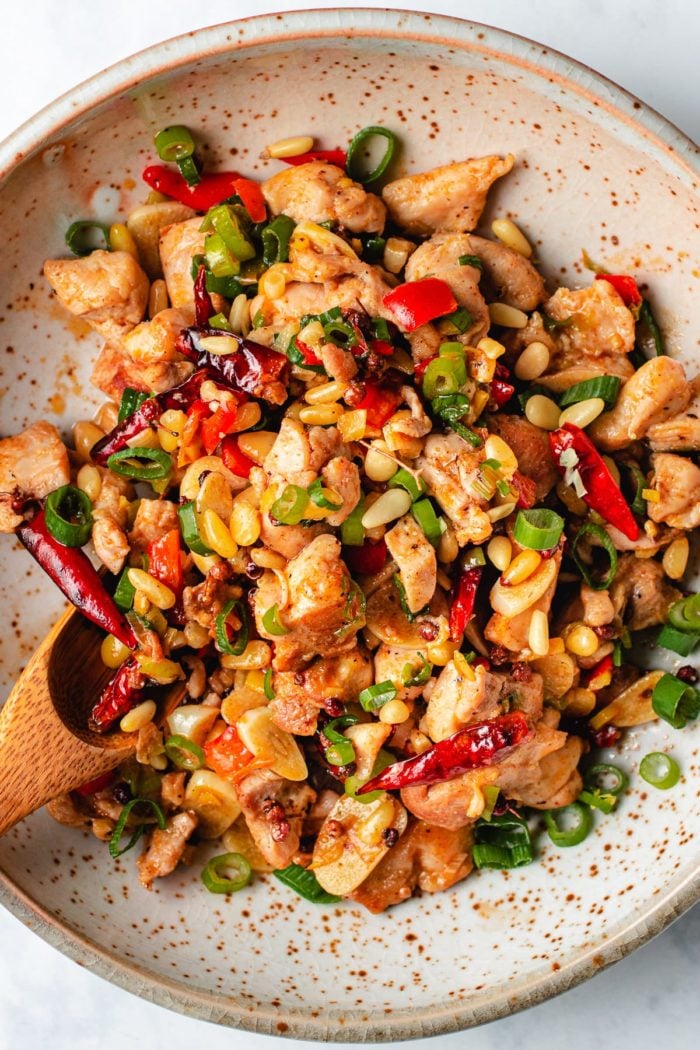
Table of Contents
- The Best Kung Pao Chicken Recipe (Paleo, Whole30, Keto)
- What is kung pao chicken
- Ingredients for Paleo Kung Pao Chicken Stir-Fry
- Paleo Kung Pao Sauce
- Sichuan peppercorns (szechuan pepper)
- Do you use Sichuan peppercorns whole or grind?
- Chinese whole dried chili peppers
- How to make kung pao chicken
- Can I make this dish less or non-spicy? I don’t have sichuan peppercorns
- Tips for making the best kung pao chicken
- Pairing suggestions for Kung Pao Chicken
- More Paleo Whole30 Keto Chinese Food
- Kung Pao Chicken (Paleo, Whole30, Keto)
The Best Kung Pao Chicken Recipe (Paleo, Whole30, Keto)
There are good reasons why Kung Pao Chicken continues to be one of the most popular Chinese dishes in America. With so many flavors going on – sweet, salty, and with a hint of heat – no wonder people can’t get enough of these super addictive chicken stir-fry.
I am going to show you how to make a Paleo version of your favorite Kung Pao at home easily and best of all it’s also Whole30 and Keto so if you’ve been waiting to make this dish gluten-free, read on! It’s one of my most popular Chinese signature dishes on the blog.
What is kung pao chicken
Kung Pao Chicken is not a saucy stir-fry dish, meaning the chicken cubes shouldn’t be overly drenched in sauce. Each chicken cubes should be crisp yet tender and lightly coated with a sweet and salty Kung Pao sauce.
The name of Kung Pao comes from a court official, Ding Baozhen from the Sichuan province in Qing dynasty, who loves stir-fried chicken with dried chili peppers. When he is granted the title Taizi Shaobao (also known as Kung Pao), people name the dish after him to honor his legacy.
Kung Pao Chicken (Mandarin: 宫保雞丁), also transcribed as as Gong Bao or Kung Pow, is a spicy stir-fried dish, featuring small cubes of boneless chicken, peanuts, and chili peppers.
- 宫保 (Gōngbǎo) is named after a court official Ding Baozhen.
- 雞 (Jī) means chicken
- 丁 (dīng) means tiny cubes.
This dish is not only beloved by people in China and Taiwan but also all over the world!
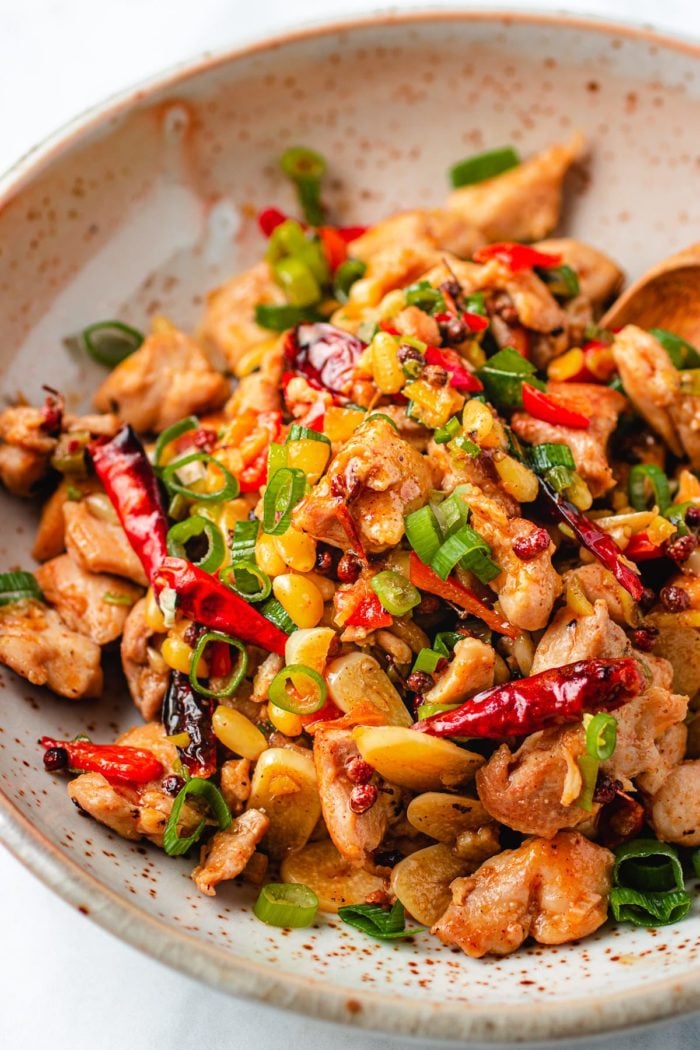
Save This Recipe
Ingredients for Paleo Kung Pao Chicken Stir-Fry
This dish is actually relatively easy to make at home and don’t feel intimidated by some of the ingredients in the recipe because you can get them either in local Chinese grocery stores or order them online. I also included workaround methods in the recipe card, if you want to make this dish in a pinch.
The main ingredients are –
- Chicken
- Pine nuts or Cashew nuts (to replace peanuts)
- Garlic, ginger, scallions
- Sichuan peppercorns
- Chinese dried red chilis
- Coconut aminos (to replace soy sauce)
- Rice or apple cider vinegar
I also use Harissa chili paste in my Kung Pao sauce to make this dish extra tasty. More info below.
Paleo Kung Pao Sauce
Kung pao sauce, along with Sichuan peppercorns and Chinese dried chilis, is the soul of kung pao chicken. The sauce is brown in color because of the dark soy sauce (and sometimes also includes light soy sauce) that contains caramel coloring and sugar.
Harissa chili paste is by no means a common ingredient in the Kung Pao Chicken recipe but I found that it compliments coconut aminos well as the paste makes the sauce saltier and the flavor more obvious. The chili paste here also acts as a binding agent to thicken the sauce.
Whole30 Kung Pao Sauce Ingredients –
- Coconut aminos
- Rice vinegar (or apple cider)
- Harissa chili paste
- Little arrowroot powder
The sauce tastes salty, a little sweet, vinegary, and with a hint of spicy flavor. Add it to the skillet and watch it bubble and turn into a beautiful, slightly thick and silky sauce that coats each piece of chicken beautifully. Super addictive!
If you have small children at home, try substitute tomato paste for Harissa chili paste.
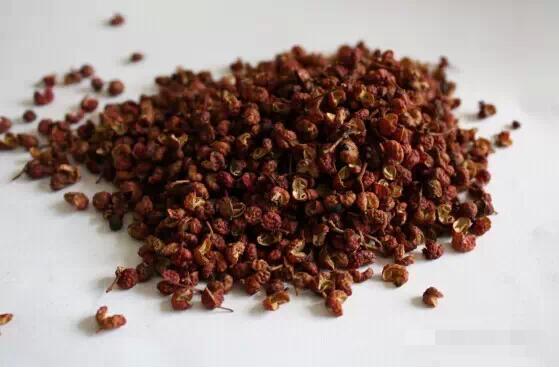
Sichuan peppercorns (szechuan pepper)
Sichuan peppercorns (花椒, huājiāo) is a spice from the Sichuan province where my grandmother came from. They have a unique aroma that’s neither spicy like chili peppers and nor pungent like black peppercorns.
Sichuan peppercorn has a lemony undertone and create a tingly and numbing sensation in the mouth , which we call Ma (麻) means numb. This spice is often used with Chinese dried chilis to create 麻辣 (Numb-Spiciness) in Sichuan cuisine.
Do you use Sichuan peppercorns whole or grind?
It depends and I’ve seen them used in both ways. In general, whole peppercorns are used to fragrant the oil. Once they turn a darker brown color, scoop them out and leave the fragrant oil behind then begin your stir-fry. If you or your guests aren’t used to Sichuan peppercorns, this method might be a good way to go so that they won’t bite into them.
However, in an authentic Chinese meal, whole peppercorns are often kept in the dish when served.
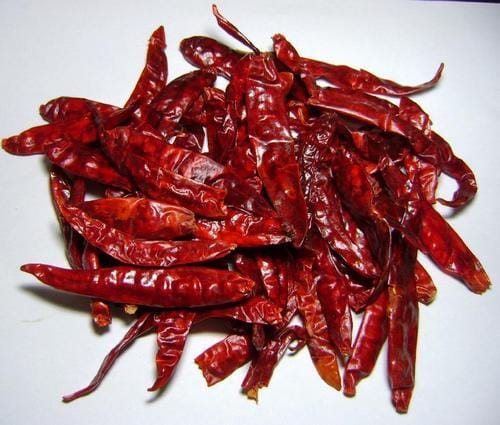
Chinese whole dried chili peppers
There are many varieties of Chinese dried red chilis. The-smaller-the-spicier. I personally like larger size chili peppers. Look for ones with beautiful deep and rich red color and the skin has a light sheen.
Most of the time I use them in whole to give dishes a slightly spicy flavor as the seeds are contained inside the peppers and thus less spicy. The whole peppers also add a great visual effect to a dish, for example my Mongolian Chicken and Cumin Beef.
A traditional Chinese dish, called Laziji (辣子雞), the chili peppers are cut open with seeds exposed and therefore it’s naturally spicier than Kung Pao Chicken. When chili peppers are cut open, we often remove the seeds to tone down the spiciness before adding the peppers to stir-fry.
Just remember that these dried chilis are for aroma and they aren’t meant to be eaten so do NOT eat them. Simply push them aside the plate when serving, it’s part of the fun. 🙂
How to make kung pao chicken
You can use chicken thighs or breasts. Dice them to small bite-sized cubes and add seasonings. The smaller cubes the better.
- Get your wok (or saute pan) hot then add avocado oil. Fry the chicken until they are golden brown on the outside and almost cooked through. Transfer them to a serving plate.
- Add more oil then saute the garlic, ginger, scallions, Sichuan peppercorns, and Chinese dried chilis until fragrant. Take care not to burn them.
- Add the chicken to the wok and the Kung Pao sauce. Give everything a quick toss to coat the sauce evenly. Serve hot with steamed white rice.
Note: If you prefer to remove the Sichuan peppercorns (i.e. only used to fragrant the oil), saute the peppercorns with oil first until the color turns dark brown, but not burnt. Remove them with a spatula then add the garlic, ginger, scallions…etc.
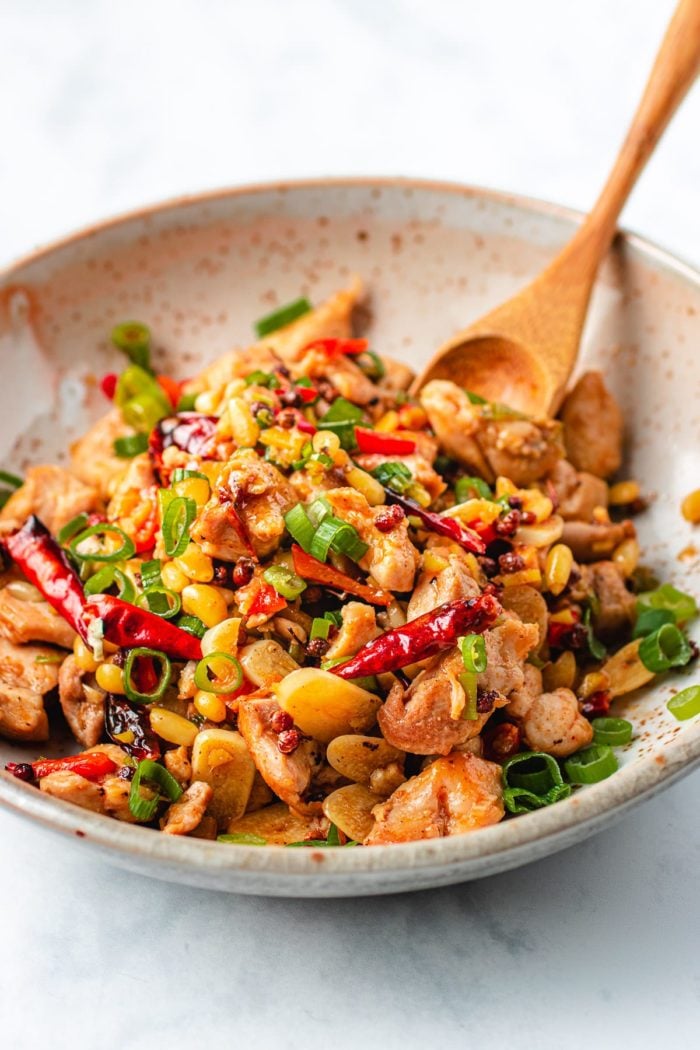
Can I make this dish less or non-spicy? I don’t have sichuan peppercorns
The spicy and numbing effect are the characteristics of Kung Pao Chicken! However, the good news is you can control the level of spiciness to your liking.
If you can’t find Sichuan peppercorns and Chinese dried chilis or prefer to make this dish less spicy or non-spicy. Here is my workaround. Although it won’t taste as authentic but will still be very yummy and tasty.
- Substitute ¼ tsp ground black pepper + 2 tsp lemon zest for Sichuan Peppercorn.
- Substitute tomato paste for Harissa chili paste.
- Substitute red bell peppers for Chinese dried red chili peppers.
Tips for making the best kung pao chicken
This Paleo Kung Pao Chicken comes together very quickly as long as you have all the ingredients prepped first before stir-frying.
- Dice the chicken to small-size cubes. This is the key to having flavor chicken that every bite is full of flavor.
- Garlic, ginger, and scallions bring so much flavor to this dish so don’t skip them.
- Sichuan peppercorns can be used in two ways – 1) Used to fragrant the oil then scoop them out, if you aren’t used to the numbing sensation or 2) Leave them in the dish as most authentic Chinese dishes are kept in the dish.
- Chinese dried red chilis – I use them in whole to add color to the dish. They do add a bit of spiciness to the stir-fry but not mouth-burning spicy as the seeds are contained inside. And most importantly, Do Not eat them. They are used for aroma and to fragrant the oil.
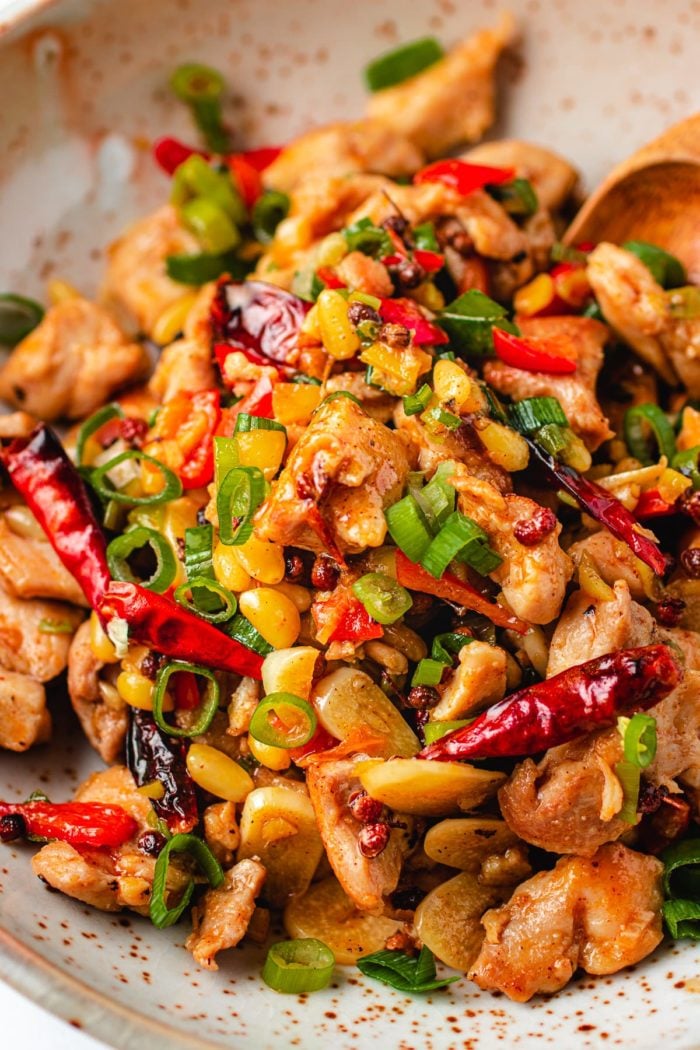
Pairing suggestions for Kung Pao Chicken
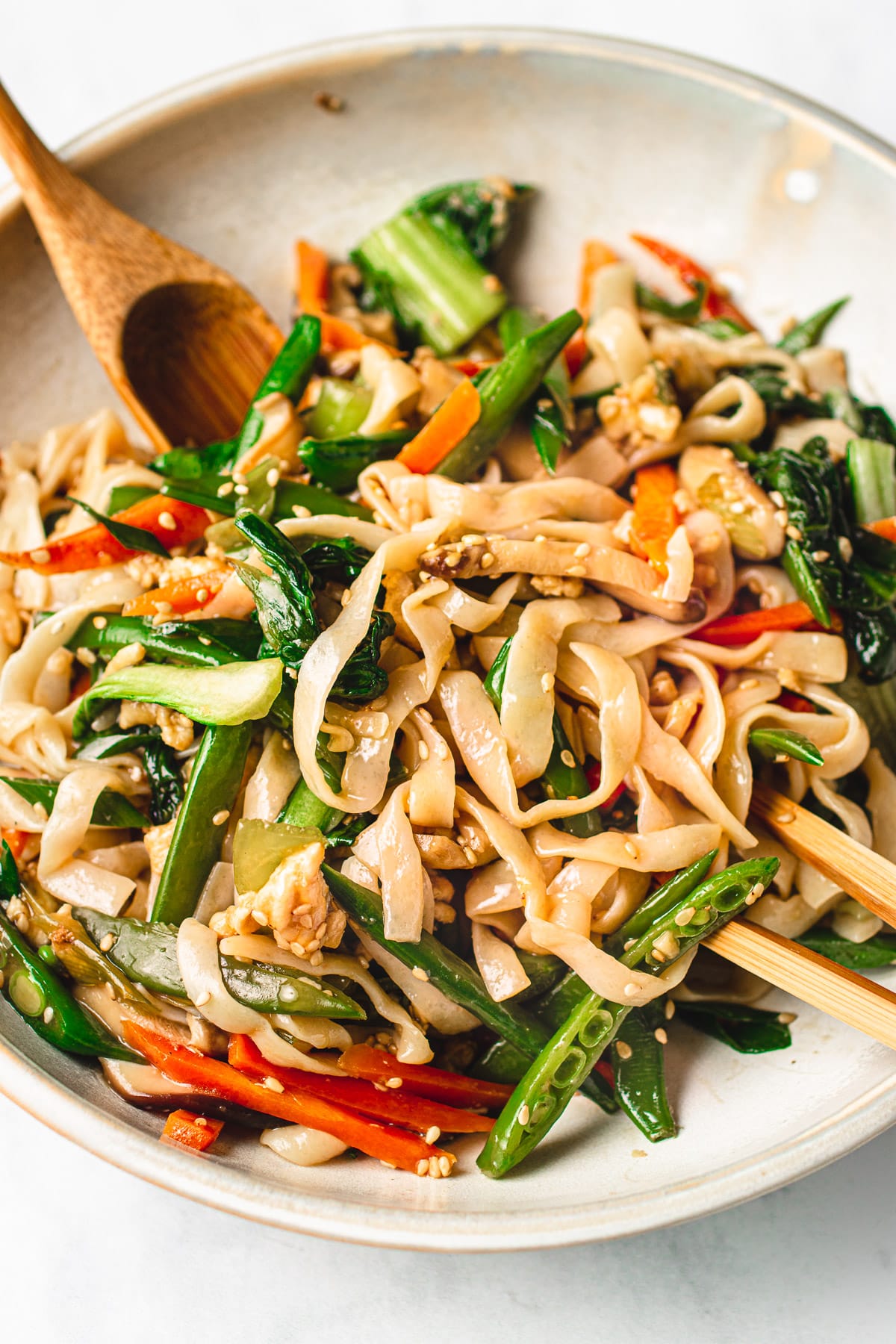


- Roasted Cauliflower Recipe
- Grilled Peach Salad
- Korean Zucchini Side Dish
- Keto Chicken lo Mein
- Thai Peanut Sauce Cucumber Noodles
- Chinese Smashed Cucumber Salad
- Asian Chicken Cabbage Salad
- Whole30 Meal Prep Recipes
- More Keto recipes
- More Paleo Salad recipes
More Paleo Whole30 Keto Chinese Food
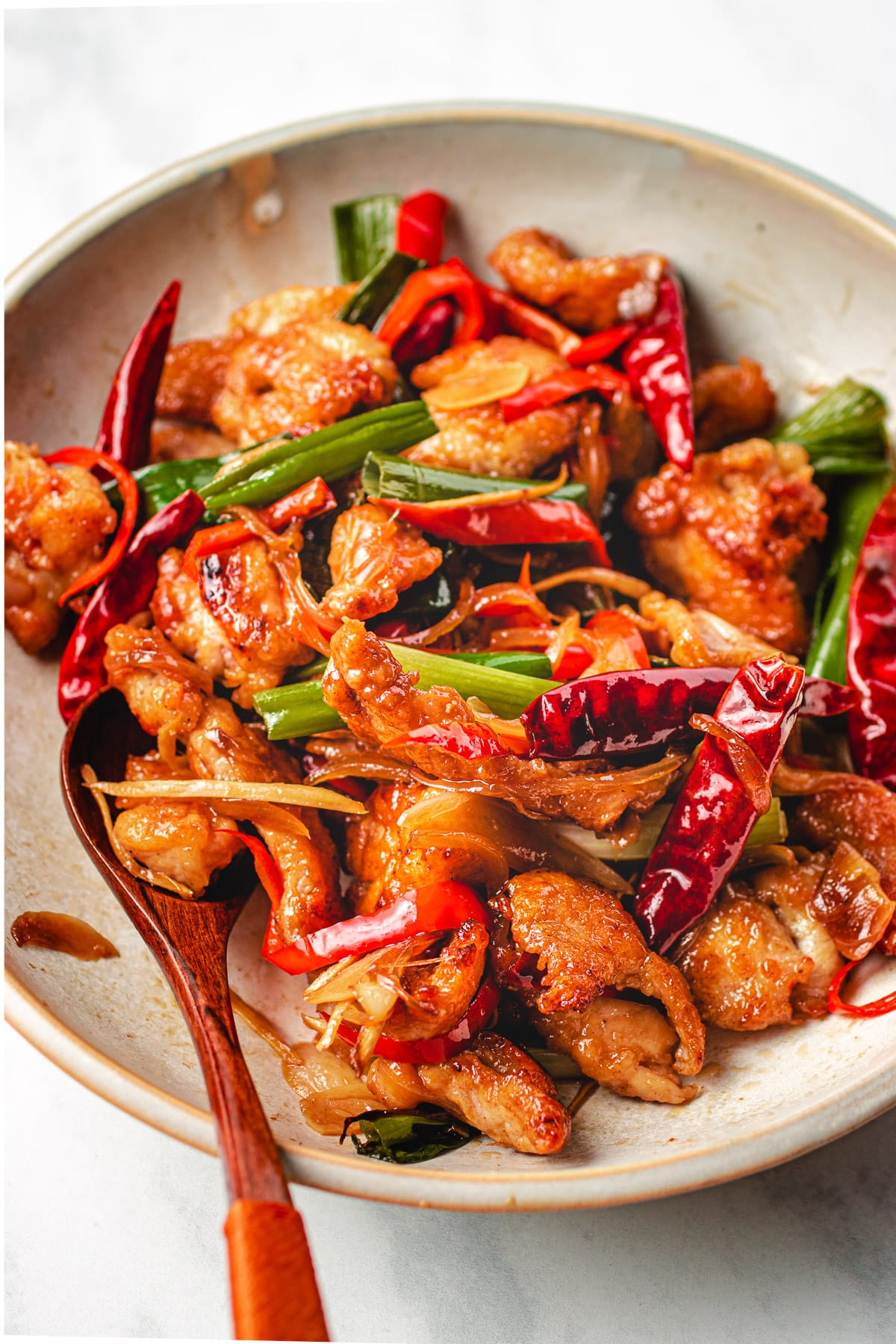
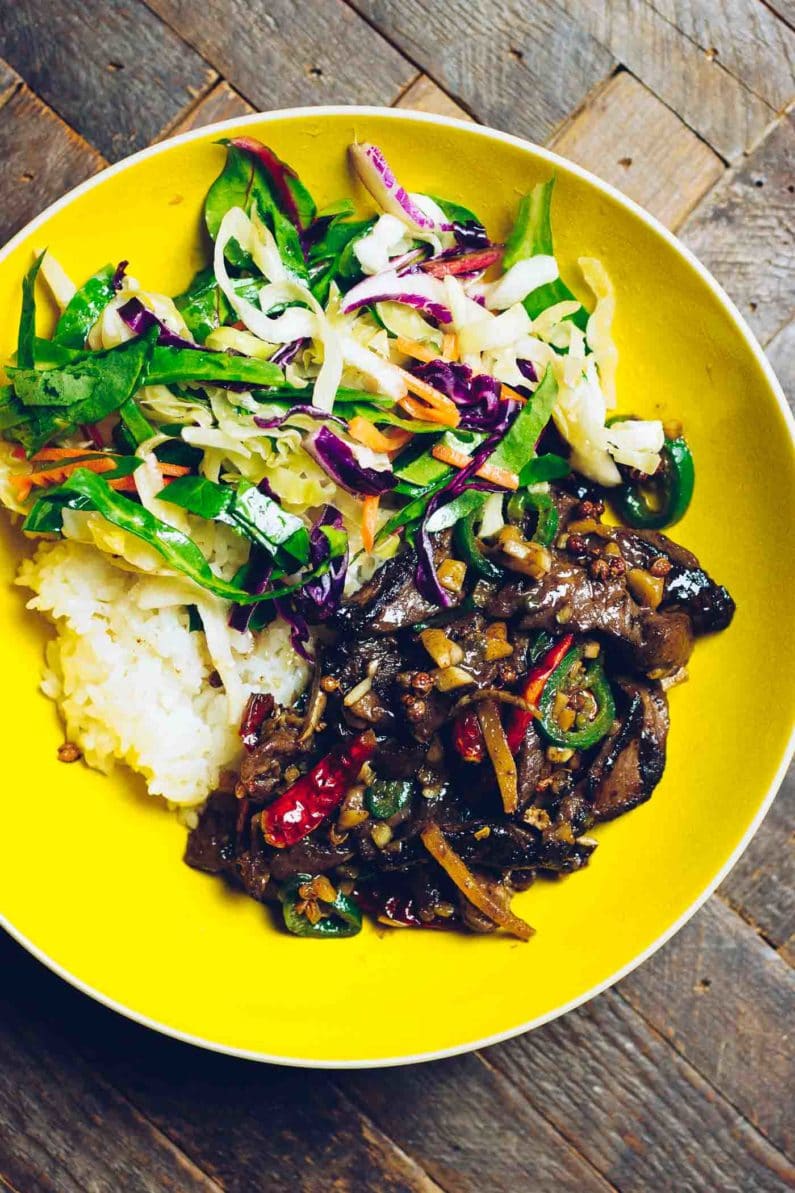
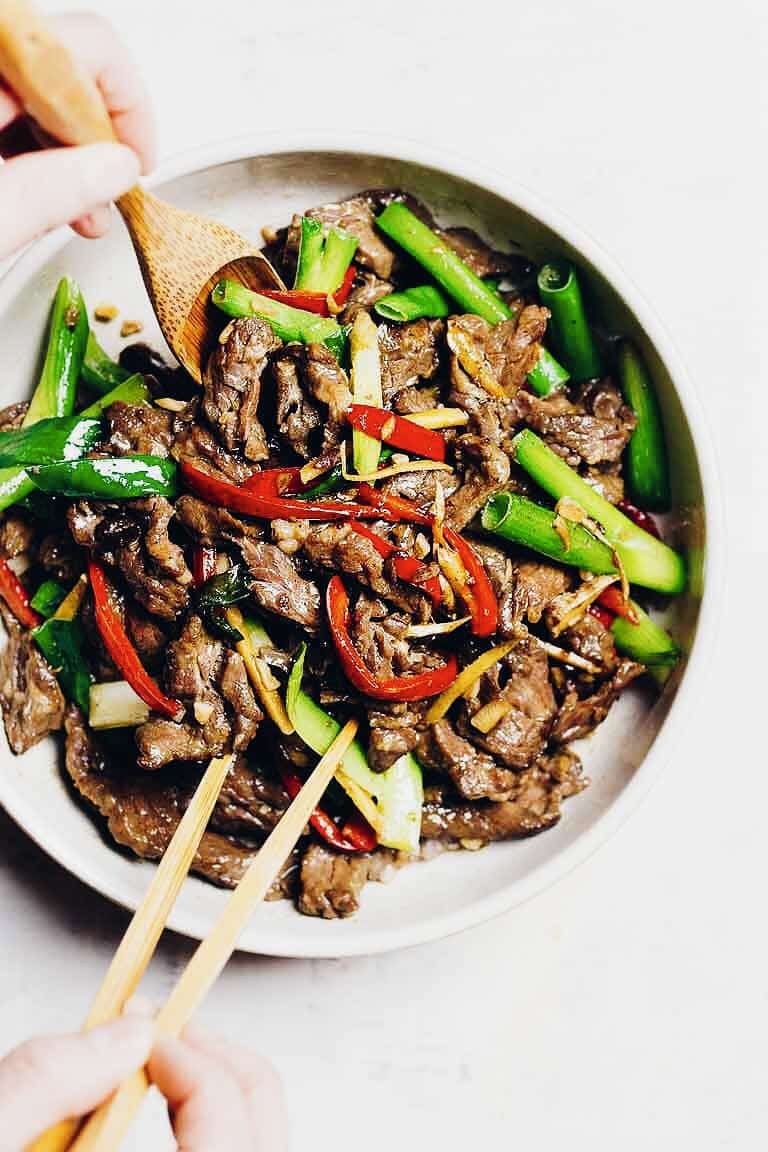
- Crispy Chinese Chicken Wings
- Paleo chicken stir-fry with napa cabbage
- Chinese Sesame Chicken
- Chinese Pepper Steak
- Mongolian Beef Recipe
- Stir-Fried Beef In Oyster Sauce
- Paleo Sichuan Dry-Fried Green Beans
- Paleo Hunan Beef Stir-Fry
- Beef and Broccoli
- Black pepper chicken
- Chinese Kung Pao Shrimp
- Chicken and Broccoli
- Moo goo gai pan
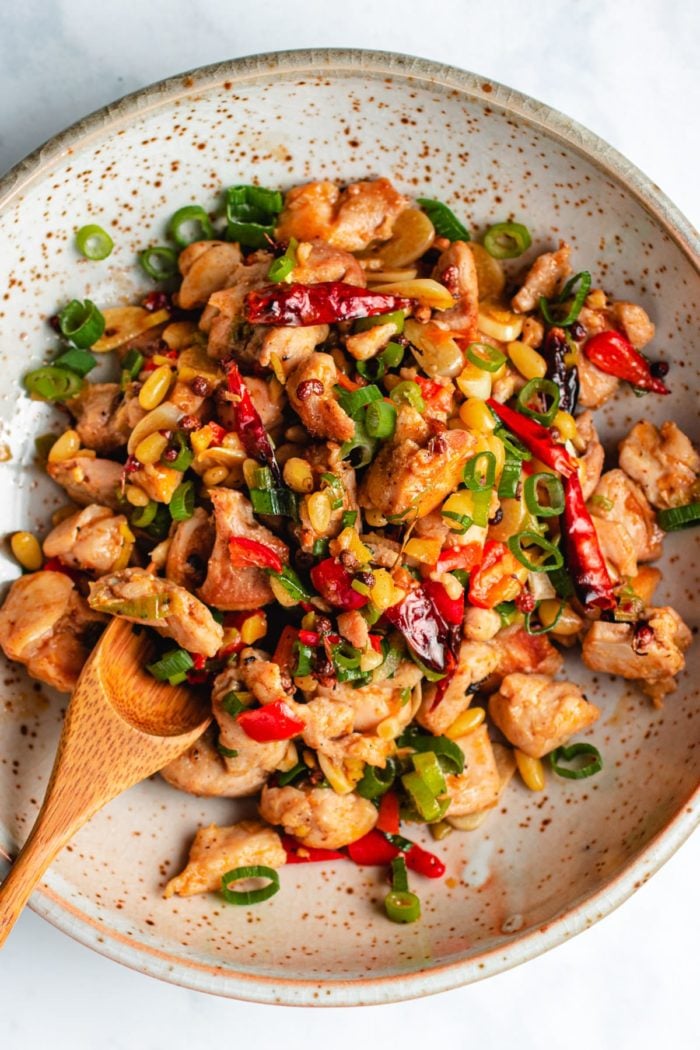
Kung Pao Chicken (Paleo, Whole30, Keto)

Ingredients
- 1½ lbs chicken breasts or thighs boneless/skinless
- Avocado oil
- Raw pine nuts or cashew nuts
- 1 tsp Toasted sesame oil optional
Kung Pao Chicken marinade:
- 1 ½ tbsp coconut aminos
- ¼ tsp garlic powder
- ¼ tsp onion powder
- ¼ tsp coarse salt
- ½ tsp arrowroot powder
Aromatics:
- 3-4 clove garlic sliced
- 1 tbsp ginger finely chopped
- 2-3 bulbs scallions chopped (reserve some green parts for serving)
- 5 whole Chinese dried red chilies See notes
- 1-2 tsp Whole Sichuan peppercorns See notes
Paleo Kung Pao Sauce:
- 2 tbsp coconut aminos
- 1 tsp rice vinegar alt. Apple cider vinegar
- 1 tsp Harissa chili paste sub. Tomato paste
- ¼ tsp arrowroot powder
Instructions
- Dice the Dice the chicken to small-bite size cubes, about half-inch (1.5cm). Add the Kung Pao Chicken marinate for 10-15 mins. Gently stir-well. Set aside in the fridge.
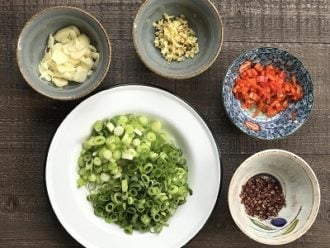
- Prepare the garlic, ginger, scallions, chilis, and peppercorns. Set the green scallion parts aside for garnishing. In a bowl, stir-well the Kung Pao sauce.

- Preheat a large stainless steel skillet or wok over medium-high heat, when hot, add 1 to 1 ½ tbsp cooking oil. Add the chicken. Pan-fry them in a single layer so each piece gets crisp up in golden brown color, about 3 minutes. Then use a spatula with a firm tip to flip and cook for 1-2 minutes on the flip side. Transfer them to a plate to keep warm.
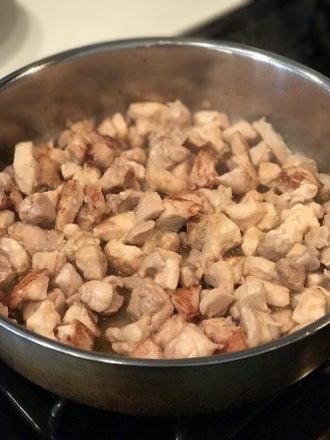
- While the skillet is still hot, add 1 to 1 ½ tbsp more cooking oil. Add the aromatics. Season with a small pinch of salt and saute until fragrant, about 8-10 seconds. Take care not to burn the spices.

- Add the chicken and pine nuts to the wok. Give the Kung Pao Sauce another stir before adding it to the wok. Quickly toss and stir-fry to coat the sauce over. Off heat. Serve hot and immediately. Garnish with green scallion parts. Drizzle with sesame oil, if using.
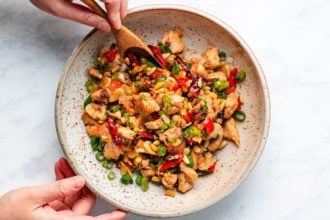
Notes
- Substitute ¼ tsp ground black pepper + 2 tsp lemon zest for Sichuan Peppercorn.
- Substitute tomato paste for Harissa chili paste.
- Substitute red bell peppers for Chinese dried red chili peppers.
Nutrition
Nutrition information is automatically calculated, so should only be used as an approximation.
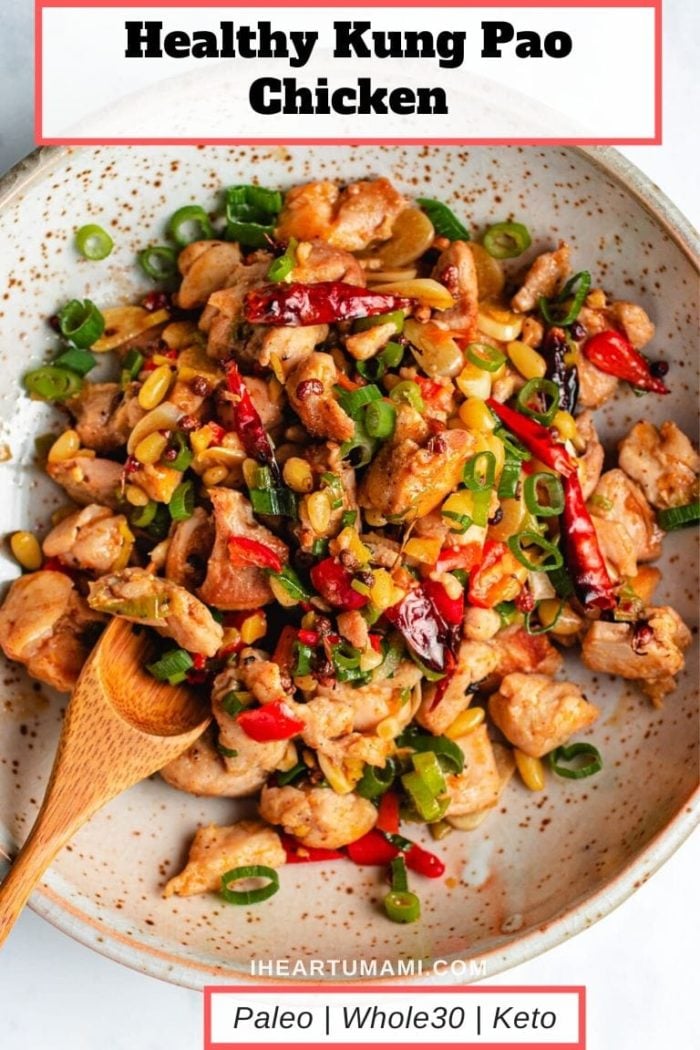
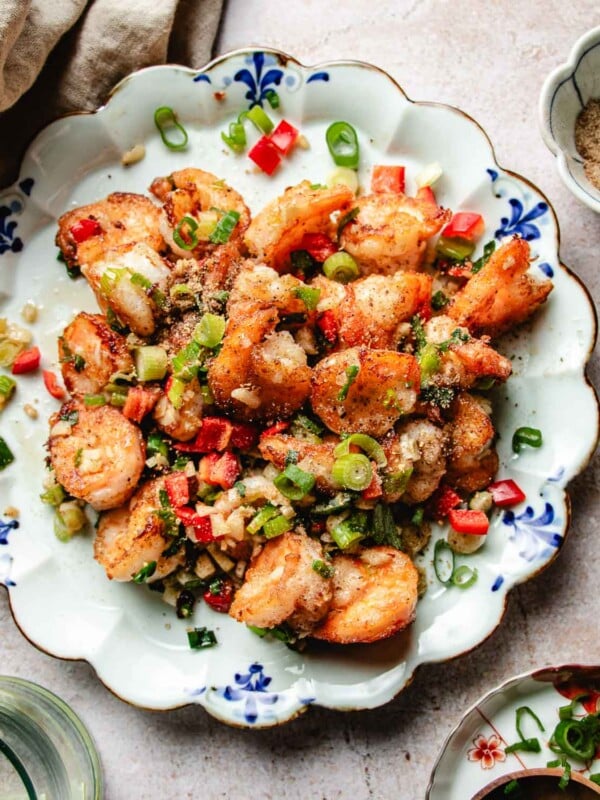
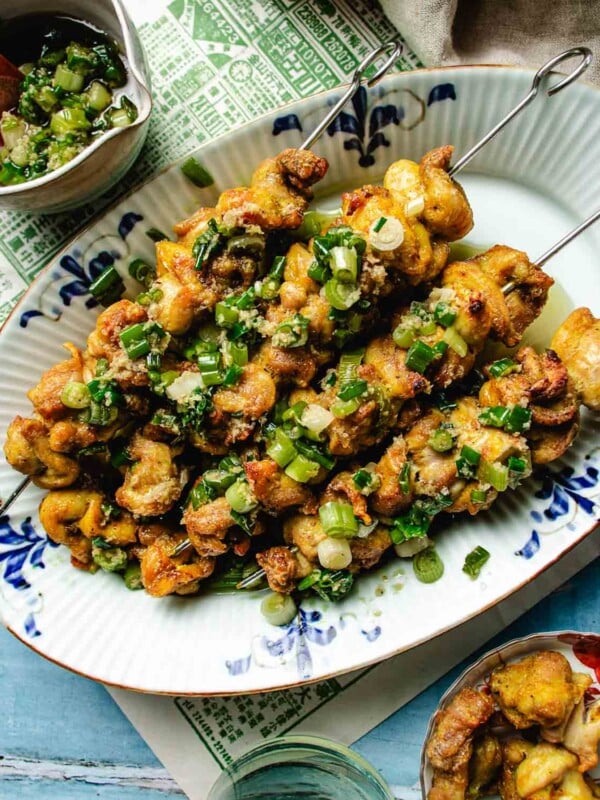
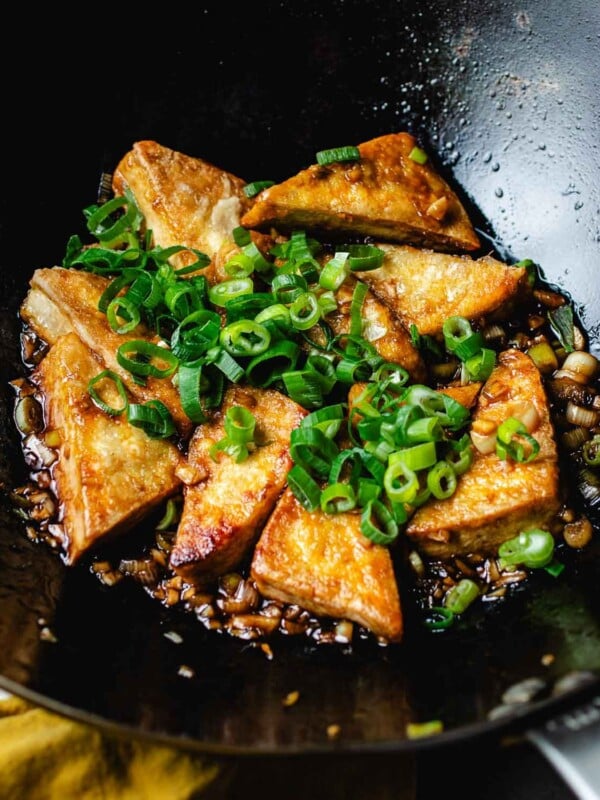










I don’t usually leave ratings, but this recipe is seriously a 5/5. Haven’t come across a recipe I liked this much in a while. This is definitely going to be a meal we make often. Thank you!
Thanks so much!
Another 5-star amazing recipe! I can’t believe how easy your recipes are to follow and how every recipe seems more flavorful than the last. This will be be on our regular rotation from now on!
Amazing!! Broke the mouth good!
Ohhhh thanks! 😀
Tasty! I would say it takes longer to prepare than the recipe specifies, though 😅, maybe because the chicken takes a while to debone and cut.
I used the substitute for Sichuan peppercorns as I couldn’t find them, and also I couldn’t find tomato paste where I’m at so I used tomato pesto sauce. The substitute for Sichuan peppercorns is really clever with the lemon zest!
Turned out fabulous. My boyfriend and I enjoyed the meal. So tasty! Will definitely make this again.
Best keto kung pao recipe we’ve tried so far. Purchasing the harissa paste and peppercorns were absolutely worth it! Keep your amazing asian dishes coming I Heart Umami!
Thank you!
I did this with a mix of scallops and shrimp instead of chicken. I also threw some chopped onions and green bell peppers into the wok to sear them and then removed before proceeding with the recipe, then added them back in at the end right after the seafood was mostly cooked. It came out great 🙂
You are making me hungry!